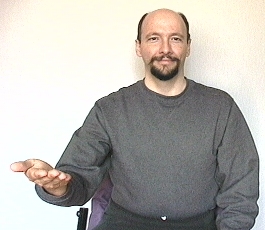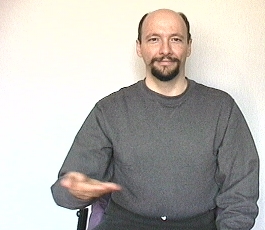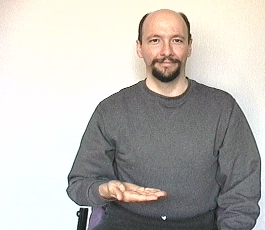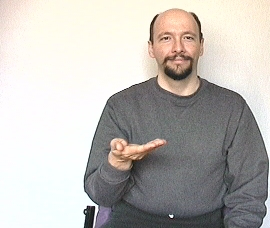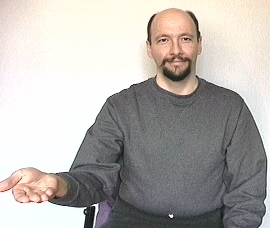American Sign Language: "hire / invite / welcome"
The sign for "hire / invite / welcome"
This one little sign has many meanings.
To fully understand this sign it is important that you see the page: "WELCOME"
This version is good for saying things like:
"I want to hire an assistant."
"Welcome! Come on in!"
"We need to invite more people to our party."
Okay, wake up now this next one is tricky. It is different. Suppose someone invited me to their place or someone hired me or made me feel welcome, I'd do the sign "HIRE" starting near me and move it toward the other person. Think of this sign as meaning "I was hired by him." "I was welcomed by him." "I was invited by him."
he-HIRE-me:
Discussion: When used to mean "invite" or "hire," this sign is "directional." Which is to say it incorporates subject/verb agreement information. (It gives information regarding who did what to whom without having to use or include extra signs for the subject and object.) If you start the sign near your body and move toward the other guy, it means he hired or invited you. If you start it near him and move it toward your body it means that you hired or invited him. (The sign HIRE or INVITE is backwards from most signs that incorporate subject verb agreement. For example compare the sign "GIVE." If I want to say "I GIVE (it to) YOU," I'd start the sign GIVE near me and end it near you.).
OPTIONAL READING:
In a message dated 2/10/2003 8:58:49 PM Central Standard Time, ledwards72@adelphia.net writes:
Dr. Bill,
If you are signing "he hires me", why would you start the sign near yourself? When you sign "he gives me" you start the sign near him and move it toward yourself. What's the difference?
Lynn
Lynn,
GREAT question.
The short answer? Because I said so.
Ha!
And the reason I say so is because that is the way it is done by advanced signers in the Deaf Community.
That is the "way it is done." It doesn't have to be a reason. Why do you say the word dog? Maybe you should instead say "woof" to mean dog? You say dog because everyone else in your group says the word dog to refer to a dog.
Now for the long answer that you are seeking:
The signs "GIVE" and "HIRE" are both verbs.
The grammar rule is simply different for these two verbs.
For the sign GIVE, the grammar rule is that the first location of the sign indicates the subject.
For the sign "HIRE" the grammar rule is that the first location of the sign indicates the object.
Why is the grammar rule different for these two verbs?
To answer that, let me ask you why it is in English that one of these two sentences is correct?
"Me am happy to meet you."
"I am happy to meet you."
The second one is correct for two reasons:
1. When you were growing up that is how you heard it. You became used to it. Now when you see it any other way it looks funny. It is what we call a social convention or a norm.
2. Society has codified it in grammar texts as a rule.
So then, why do we sign HIRE in an "object location first" manner?
Same reasons: It is a convention and it is in a grammar text (or at least it is in your ASL Linguistics text).
Now, that doesn't necessarily make it any easier to accept does it? So, fine, I'll give you a perspective on the sign that is totally made up and bogus but "sounds good."
Here we go:
When I hire you it means I bring you into my organization. At first you are over there, then I hire you and bring you closer to me in my organization. Therefore the concept "I hire you" starts away from my body (near you) and moves closer to my body representing the movement of you toward my organization (me).
Now then, if you hire me, that means I get to come onboard your organization. The concept "you hire me" is then shown by the movement of a sign that brings me closer to you, which is to say it starts near me and moves toward you because you are pulling me into your company.
Now, the fact is, not everybody follows that convention. Many, many signers don't follow it.
An important point though is that most advanced signers are aware of the convention and make use of it or at least recognize it when others use it.
Now, I thought and thought until I could come up with another sign that follows the same convention as HIRE.
An example would be the sign PULL.
If my concept is "I pulled him" (as in the car was burning and I pulled him out).
Where would I start the sign? I am the subject because I'm doing the action. Should I start the sign near me? No. I'd reach out and "grab him" (mime) and then pull him toward me.
If I wanted to indicate "he pulled me" I'd grab my shirt or grab near my body and then lurch forward/off-to-the-side as I pulled my hands forward/off-to-the-side. He is the subject, but the sign starts near me and moves toward him. As in the sign for HIRE the object-location is shown first.
Twenty years from now will the Deaf Community still be signing HIRE by indicating the object-location first? Who knows?
Language changes. I guess we will find out in 20 years.
If you have other questions about the sign HIRE, please do let me know.
- Dr. Bill
In a message dated 2/15/2003 9:56:14 AM Central Standard Time, lstuber@ writes:
Dr. Bill,
I asked my professor who is Deaf at Onondaga Community College in Syracuse, New York about this question before I had a chance to read your reply. He didn't like the book's answer either. He signed it the same way I did. Since asking him, I have come home and read your answer to my question. I still don't like it. I also don't like the example with pull. If I was going to sign "I pull him" I would sign " me" then start at the other person and pull towards myself. If I were to sign "he pulls me" I would sign "he" then sign "pull" from myself toward him. For me, it is clearer than what the book recommends. But, as you stated, not all signers do it that way. I also realize that no two signers are going to sign everything the same way. I hope you don't think I am being disagreeable, I miss the interaction of a classroom where I can ask you directly and have you show me as well as explain it to me. My fiend tells me just to accept what professors tell me without question and get my credit and move on. I just don't function that way. I need to know why and have it cleared up, whether or not we agree. Thanks for your time.
--Lynn
Dear Lynn,
I love discussing linguistics with my students. I respect that you question the things which your professors tell you. I was, and still am the same way (I question things) so by all means DO question what the book says and my explanation of it.
When I was younger I used to take lots of ASL classes (even though I often knew more than the instructor). I enjoyed learning the variations and teaching styles of the various instructors so that I could incorporate their best ideas into my own classes. The teachers and I had wonderful discussions. I questioned nearly everything. At one point one teacher swore and asked if I was going to be like "that" the whole semester.
(Note: Later on that teacher and I became good friends!)
I share that story with you so you will know that I consider robust discussion to be an excellent learning activity and am comfortable with it. Yes, I agree that such discussions are easier in person, but it is still good that you can be in New York and get credit for this course so you can graduate. (Yaaaay!)
Now, regarding the concept, "I pulled him" you indicate:
<<If I was going to sign "I pull him" I would sign "me" then start at the other person and pull towards myself.>>
Another way to write that might be to use the modified gloss: "PRO.1 PULL-(C to A)."
PRO.1 meaning our sign for I/ME.
PULL meaning the normal sign for pull.
-(C to A) meaning moving from a position off to the right (C) to near our own body (A).
Of course, in isolation we would tend to use the PRO.1 sign (I/ME) at the beginning of the sentence...but most ASL usage doesn't occur in isolation. Let's consider this at the discourse level. (Meaning as it would occur in a story or in a conversation.)
Suppose "he" is named Bob. If you had already established "Bob" off to the right (in a previous sentence) and were in the middle of telling a story about you and Bob, chances are you would not actually go through the effort of having to sign "I/ME" a second time. It would be understood and you wouldn't need to sign (PRO.1/I/ME) again prior to signing PULL-(C to A). We would know from the locative information that you were pulling Bob.
It is interesting to compare the sentences:
He gave it to me.
He pulled me.
He hired me.
I gave it to him.
I pulled him.
I hired him.
If you pull those sentences out of context and sign them one at a time as part of a "quiz" you end up throwing away much of the contextual information that ASL normally takes advantage of. But in real life ASL we tend to use. In context, each of those sentences could be signed using just one sign. For example "He gave it to me," would be signed:
"[Preexisting info = past tense] [location information = he] GIVE [preexisting info = it] [movement-direction info = to] [location info = me]"
I would not use a separate sign for him (PRO.3) and I would not use a separate sign for me (PRO.1). I would instead rely on the location and movement to establish the subject and object of the sentence. In this case, the movement is from him to me.
So then, we can look at the direction of the movement in each of the sentences if we signed them in context with only one sign:
He GAVE it to me. [Movement = From him to me.]
He PULL me. [Movement = From me to him.]
He HIRE me. [Movement = From me to him.]
I GAVE it to him. [Movement = From me to him]
I PULL him. [Movement = From him to me]
I HIRE him. [Movement = From him to me.]
Now, some signs won't let us use the location and movement to indicate the subject and object. For example:
I love her. [Movement = no change in location]
I'm not talking about the concept of "fell in love with" but rather the general concept of love that is expressed by arms crossed over the chest. To sign the phrase, "I love her" you would, in general, sign [PRO.1-(using a separate sign "I") LOVE PRO.3-(using a separate sign "HER"].
I could (in context) just sign "LOVE PRO.3-(using a separate sign "HER" and it could be inferred that it is me that is doing the loving, but I still wouldn't move the sign LOVE in her direction. And I'd still need a separate sign to indicate her.
Grammar rules aside, it is always good to do a real world check. I see the sign HIRE used both ways, as a "plain verb" and as an "agreement verb." To use it as a plain verb requires more signs than to use it as an agreement verb. The "Hearing world" is limited to only using hire as a plain verb. Since there is a great deal of language contact between the two worlds you will see many signers using HIRE as a plain verb. The question is, "Is that, or will it eventually become the norm?" If so, the next question is, "How long will it be before what was once considered correct, will now be considered incorrect?" Who decides? We all do. It is like clothing fashion. What was fashionable in the 70's looks funny in the 2000's. But not everybody stopped wearing bell bottom pants on New Year's Day of 1980.
As of today, right now, if I gathered 100 deaf people into a room, I reckon a percentage of them would feel comfortable seeing HIRE signed as an agreement verb. A percentage of them would also look at it and think, "That looks funny to me." Some would flat out say it is wrong, and some would say it is right.
The question to ask yourself though is, what would the percentage of educated, native-level, well-traveled, users of the ASL think? Would they think differently than the typical ASL user? Which one do you want to use as your model for learning?
I tend to think that the educated, native-level, well-traveled, user would recognize and feel comfortable with both forms.
Two different approaches to Linguistics include prescriptive and descriptive.
Prescriptive: Tells you how to use the language
Descriptive: Tells you how the language is used
I consider myself to be a descriptive instructor.
It would be interesting for you to do a research paper wherein you conducted a study on the current usage of the sign HIRE.
I will offer that up to the students here in Beaumont as well. Someday perhaps someone will take up the challenge and then I'll publish the results at my website.
Have a nice day.
- Dr. Bill
Scott Mather typed up a few of his excellent insights on the sign "HIRE." Here they are (with minor edits) for the benefit of all:
Scott Mather
4/11/03Scott: I see the sign HIRE used both ways, as a "plain verb" and as an "agreement verb." To use it as a plain verb requires more signs than to use it as an agreement verb.
Using more signs is inefficient. Have you heard of Ockham's Razor? It's a scientific rule of thumb that says: given a choice of multiple options, the simplest solution or explanation is the best one.
Based on this rule, using the agreement verb for "hire" in the phrase "he hired me" is 66% simpler than using the plain verb, and so is the best (most elegant) choice.
To better understand and remember the difference, it helps me to think like this:
He GIVE it to me = He gives it to me. (Active voice)
He is the one giving, and I am the one being given to, so the direction starts with him and moves toward me.
[Active voice = use of plain form of verb.]
He HIRE me = I am hired by him. (I change the sentence structure from the active to the passive voice.)
I is the subject, so the action starts near me. Him is the indirect object, so the action goes toward him.
So HIRE, INVITE, INTRODUCE and PULL have a double nature.
When "I" am the subject of the action, they are active/plain verbs, but when "me" am the object of the action, they become passive/aggreement verbs.
I can speak "he introduced me", but I should sign "I was introduced by him".
Want to help support
ASL University? It's easy:
DONATE (Thanks!)
(You don't need a PayPal account. Just look for the credit card
logos and click continue.)
Another way to help is to buy something from the ASLU "Bookstore."
Want even more ASL resources? Visit the "ASL Training Center!" (Subscription
Extension of ASLU)
CHECK IT OUT >
Bandwidth slow? Check out "ASLUniversity.com" (a
free mirror of
Lifeprint.com less traffic, fast access)
VISIT >
You can learn
American Sign Language (ASL) online at
American Sign Language University ™
Lifeprint.com © Dr. William Vicars
